The Life Cycle Method for Understanding Media Manipulation and Disinformation – The media manipulation life cycle (MMLC) forms the basis of the Casebook, giving a common framework for journalists, researchers, technologists, and members of civil society to understand the origins and impacts of disinformation and its relation to the wider information ecosystem. Situated in the emerging field of Critical Internet Studies, this research methodology combines social science and data science to create a new framework for studying sociotechnical systems and their vulnerabilities. Methods – The means for documenting case studies require a variety of methods that span quantitative analysis, content analysis, network mapping, and ethnographic studies. As such, a variety of indicators from different sources (e.g., commercial threat reporting, platform reporting, independent research, investigative journalism, public statements, website scraping) will be used to triangulate the findings. In addition, each case study will vary in the methods used to detect and document the operations, depending on the availability of evidence. Where original research and analysis was undertaken, source material will be presented and cited. For more information on the life cycle model, selection criteria, coding process, and research methods, please refer to our code book and our primer on investigative digital ethnography….”
The Verge - New Google search features make it easier to find the right docto
The Verge: “As part of efforts to expand the health information it provides, today Google announced a new feature in search that will allow doctors to list which languages they can speak at their offices. People who speak languages other than English often struggle to navigate the healthcare system in the United States and are at risk of bad medical outcomes because they have more trouble communicating with providers. They get better care when they have access to trained interpreters or are seen by providers who speak their native languages. In a blog post, Google also drew attention to other recently added features that address challenges patients face with the health system, including the ability to see what insurance networks are accepted by providers listed in a search. On mobile, people can also now filter by providers who accept Medicare, a capability that spokesperson Iz Conroy told The Verge has been ramping up over the past few months…”
Is Private Equity Overrated? NYT. Good to see Dealbook catching up.
The new ‘government by diktat’ bypasses parliament altogether FT
Photographer Carla Rhodes: “Wintertime allows me to partake in one of my favorite pastimes… Feeding the birds! During the warmer months, it’s simply unethical to hang a bird feeder in my area (Catskill Mountains, New York, USA) especially as they attract my curious, hungry neighbors… Black bears. “Beneath The Bird Feeder” is a photographic project starring many feathered (and furred) visitors. Subjects were photographed daily via a DSLR camera trap positioned underneath my bird feeder during the winter months of 2020-2021. This project reveals insights into species behavior while showing the viewer a new perspective on a common pastime. Ethical considerations were at the forefront of this project. This included hanging the feeder in a tree away from house windows. If not cared for properly, bird feeders can be a vector for diseases, such as salmonella. To avoid this issue I regularly raked beneath the bird feeder (and turned the soil below), rotated the feeder to different branches, occasionally allowed the feeder to be empty, and regularly disinfected the feeder with dish soap and dilute bleach solution. Additionally, my garden stays ‘wild’ during the colder months, offering options beyond the bird feeder. I strongly believe if you engage in feeding the birds, you should do it responsibly! Throughout this project, I asked myself many questions. What kind of ecosystem does a bird feeder create? As a result of birds dropping seeds, what other creatures would this attract? When the sun went down, deer mice would gather the aforementioned seeds, caching them in a stone wall near the bird feeder (often helped along by the adorable yet venomous Northern short-tailed shrew). When day broke, an assortment of looters (from birds to squirrels) would raid the cached bounty. Insights into behavior continually intrigued me. Dark-eyed juncos were always the first birds to show up at the crack of dawn while Northern cardinals would always show up at dusk. I started to recognize regulars and grew particularly fond of a deer mouse with a notch in his/her ear, who I eventually named ‘Notches.’ “Beneath the Birdfeeder” is slated to be published and this page will be updated accordingly…” [See also her Instagram site]
